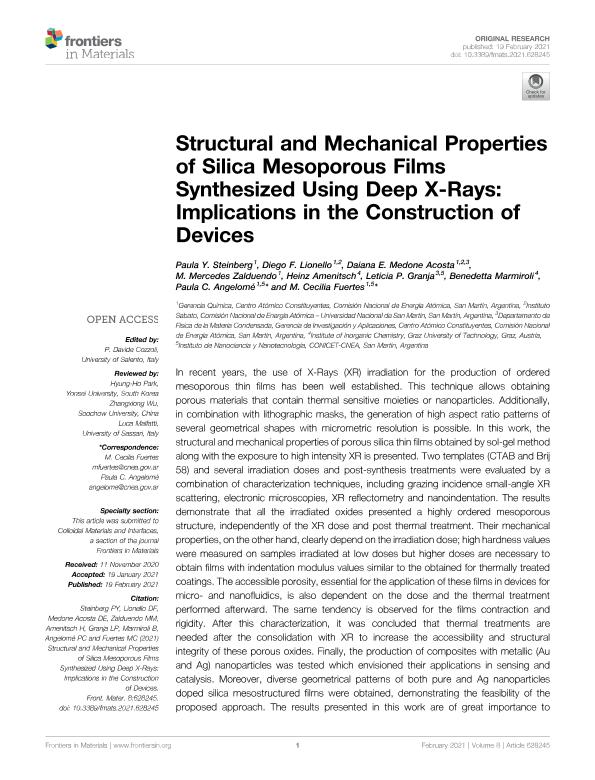Mostrar el registro sencillo del ítem
dc.contributor.author
Steinberg, Paula Yael

dc.contributor.author
Lionello, Diego Fernando

dc.contributor.author
Medone Acosta, Daiana Elizabeth

dc.contributor.author
Zalduendo, María Mercedes

dc.contributor.author
Amenitsch, Heinz
dc.contributor.author
Granja, Leticia Paula

dc.contributor.author
Marmiroli, Benedetta
dc.contributor.author
Angelome, Paula Cecilia

dc.contributor.author
Fuertes, María Cecilia

dc.date.available
2022-03-23T01:19:12Z
dc.date.issued
2021-02-19
dc.identifier.citation
Steinberg, Paula Yael; Lionello, Diego Fernando; Medone Acosta, Daiana Elizabeth; Zalduendo, María Mercedes; Amenitsch, Heinz; et al.; Structural and Mechanical Properties of Silica Mesoporous Films Synthesized Using Deep X-Rays: Implications in the Construction of Devices; Frontiers Media; Frontiers in Materials; 8; 628245; 19-2-2021; 1-13
dc.identifier.uri
http://hdl.handle.net/11336/153789
dc.description.abstract
In recent years, the use of X-Rays (XR) irradiation for the production of ordered mesoporous thin films has been well established. This technique allows obtaining porous materials that contain thermal sensitive moieties or nanoparticles. Additionally, in combination with lithographic masks, the generation of high aspect ratio patterns of several geometrical shapes with micrometric resolution is possible. In this work, the structural and mechanical properties of porous silica thin films obtained by sol-gel method along with the exposure to high intensity XR is presented. Two templates (CTAB and Brij 58) and several irradiation doses and post-synthesis treatments were evaluated by a combination of characterization techniques, including grazing incidence small-angle XR scattering, electronic microscopies, XR reflectometry and nanoindentation. The results demonstrate that all the irradiated oxides presented a highly ordered mesoporous structure, independently of the XR dose and post thermal treatment. Their mechanical properties, on the other hand, clearly depend on the irradiation dose; high hardness values were measured on samples irradiated at low doses but higher doses are necessary to obtain films with indentation modulus values similar to the obtained for thermally treated coatings. The accessible porosity, essential for the application of these films in devices for micro- and nanofluidics, is also dependent on the dose and the thermal treatment performed afterward. The same tendency is observed for the films contraction and rigidity. After this characterization, it was concluded that thermal treatments are needed after the consolidation with XR to increase the accessibility and structural integrity of these porous oxides. Finally, the production of composites with metallic (Au and Ag) nanoparticles was tested which envisioned their applications in sensing and catalysis. Moreover, diverse geometrical patterns of both pure and Ag nanoparticles doped silica mesostructured films were obtained, demonstrating the feasibility of the proposed approach. The results presented in this work are of great importance to understand the transport mechanisms that operate in these silica porous films, in order to integrate them in different devices for lab-on-a-chip applications.
dc.format
application/pdf
dc.language.iso
eng
dc.publisher
Frontiers Media

dc.rights
info:eu-repo/semantics/openAccess
dc.rights.uri
https://creativecommons.org/licenses/by/2.5/ar/
dc.subject
DEEP X-RAY LITHOGRAPHY
dc.subject
MECHANICAL PROPERTIES
dc.subject
MESOPOROUS THIN FILMS
dc.subject
METALLIC NANOPARTICLES
dc.subject
SILICA
dc.subject.classification
Nano-materiales

dc.subject.classification
Nanotecnología

dc.subject.classification
INGENIERÍAS Y TECNOLOGÍAS

dc.title
Structural and Mechanical Properties of Silica Mesoporous Films Synthesized Using Deep X-Rays: Implications in the Construction of Devices
dc.type
info:eu-repo/semantics/article
dc.type
info:ar-repo/semantics/artículo
dc.type
info:eu-repo/semantics/publishedVersion
dc.date.updated
2022-03-14T21:14:20Z
dc.identifier.eissn
2296-8016
dc.journal.volume
8
dc.journal.number
628245
dc.journal.pagination
1-13
dc.journal.pais
Suiza

dc.journal.ciudad
Lausana
dc.description.fil
Fil: Steinberg, Paula Yael. Comisión Nacional de Energía Atómica. Gerencia del Área de Seguridad Nuclear y Ambiente. Gerencia de Química (CAC); Argentina. Consejo Nacional de Investigaciones Científicas y Técnicas; Argentina
dc.description.fil
Fil: Lionello, Diego Fernando. Comisión Nacional de Energía Atómica. Gerencia del Área de Seguridad Nuclear y Ambiente. Gerencia de Química (CAC); Argentina. Universidad Nacional de San Martín. Instituto Sabato; Argentina. Consejo Nacional de Investigaciones Científicas y Técnicas; Argentina
dc.description.fil
Fil: Medone Acosta, Daiana Elizabeth. Comisión Nacional de Energía Atómica. Gerencia del Área de Seguridad Nuclear y Ambiente. Gerencia de Química (CAC); Argentina. Universidad Nacional de San Martín. Instituto Sabato; Argentina. Comisión Nacional de Energía Atómica. Gerencia de Área Investigaciones y Aplicaciones No Nucleares. Gerencia Física (CAC). Departamento de Física de la Materia Condensada; Argentina
dc.description.fil
Fil: Zalduendo, María Mercedes. Comisión Nacional de Energía Atómica. Gerencia del Área de Seguridad Nuclear y Ambiente. Gerencia de Química (CAC); Argentina
dc.description.fil
Fil: Amenitsch, Heinz. Graz University Of Technology.; Austria
dc.description.fil
Fil: Granja, Leticia Paula. Comisión Nacional de Energía Atómica. Gerencia de Área Investigaciones y Aplicaciones No Nucleares. Gerencia Física (CAC). Departamento de Física de la Materia Condensada; Argentina. Consejo Nacional de Investigaciones Científicas y Técnicas. Oficina de Coordinación Administrativa Ciudad Universitaria. Unidad Ejecutora Instituto de Nanociencia y Nanotecnología. Unidad Ejecutora Instituto de Nanociencia y Nanotecnología - Nodo Constituyentes | Comisión Nacional de Energía Atómica. Unidad Ejecutora Instituto de Nanociencia y Nanotecnología. Unidad Ejecutora Instituto de Nanociencia y Nanotecnología - Nodo Constituyentes; Argentina
dc.description.fil
Fil: Marmiroli, Benedetta. Graz University Of Technology.; Austria
dc.description.fil
Fil: Angelome, Paula Cecilia. Comisión Nacional de Energía Atómica. Gerencia del Área de Seguridad Nuclear y Ambiente. Gerencia de Química (CAC); Argentina. Consejo Nacional de Investigaciones Científicas y Técnicas. Oficina de Coordinación Administrativa Ciudad Universitaria. Unidad Ejecutora Instituto de Nanociencia y Nanotecnología. Unidad Ejecutora Instituto de Nanociencia y Nanotecnología - Nodo Constituyentes | Comisión Nacional de Energía Atómica. Unidad Ejecutora Instituto de Nanociencia y Nanotecnología. Unidad Ejecutora Instituto de Nanociencia y Nanotecnología - Nodo Constituyentes; Argentina
dc.description.fil
Fil: Fuertes, María Cecilia. Comisión Nacional de Energía Atómica. Gerencia del Área de Seguridad Nuclear y Ambiente. Gerencia de Química (CAC); Argentina. Consejo Nacional de Investigaciones Científicas y Técnicas. Oficina de Coordinación Administrativa Ciudad Universitaria. Unidad Ejecutora Instituto de Nanociencia y Nanotecnología. Unidad Ejecutora Instituto de Nanociencia y Nanotecnología - Nodo Constituyentes | Comisión Nacional de Energía Atómica. Unidad Ejecutora Instituto de Nanociencia y Nanotecnología. Unidad Ejecutora Instituto de Nanociencia y Nanotecnología - Nodo Constituyentes; Argentina
dc.journal.title
Frontiers in Materials
dc.relation.alternativeid
info:eu-repo/semantics/altIdentifier/url/https://www.frontiersin.org/articles/10.3389/fmats.2021.628245/full
dc.relation.alternativeid
info:eu-repo/semantics/altIdentifier/doi/https://doi.org/10.3389/fmats.2021.628245
Archivos asociados
